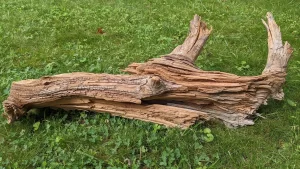Physical Address
23,24,25 & 26, 2nd Floor, Software Technology Park India, Opp: Garware Stadium,MIDC, Chikalthana, Aurangabad, Maharashtra – 431001 India
Physical Address
23,24,25 & 26, 2nd Floor, Software Technology Park India, Opp: Garware Stadium,MIDC, Chikalthana, Aurangabad, Maharashtra – 431001 India

A new study published in the journal Science suggests that old logs buried in low-permeability clay soil can retain almost all their carbon dioxide over millennia. Researchers, led by University of Maryland’s Ning Zeng, analyzed a 3,775-year-old log, finding it had lost less than 5% of its original carbon.
In 2013, Ning Zeng and his team discovered the very old, well-preserved log while digging a trench in Quebec for a wood vaulting experiment. Their goal was to bury 35 metric tons of wood under clay soil and leave it for nine years to test if it would prevent decomposition, offering a cost-effective way to store carbon. However, during the excavation, they unexpectedly found the ancient log that was much older than anything they could have created in their experiment.
Zeng explains that the ancient log is still in such good condition that it could be used for furniture, demonstrating how well-preserved it is. This preservation is due to specific environmental factors that kept the log from decaying. By studying these factors, researchers hope to improve a climate strategy called “wood vaulting.”
However, Zeng notes that it’s not as simple as just burying wood. For long-term carbon storage, conditions like those that preserved ancient wood—such as the low-permeability soil that stopped the 3,775-year-old log from breaking down—are essential.
What is wood vaulting?
Wood vaulting involves burying wood that can’t be used commercially, like trees destroyed by natural disasters or old materials, to prevent it from decomposing and releasing stored carbon dioxide—a gas that contributes to global warming. While trees naturally absorb carbon during their lifetimes, they release it back into the atmosphere when they die and decompose, making tree decay a factor in climate change. Wood vaulting offers a way to interrupt this process.
How does it help fight climate change?
This discovery could help refine climate change mitigation strategies by highlighting the potential for natural carbon storage in certain soil conditions.
‘’Six-times more carbon dioxide (CO2) is removed each year by terrestrial photosynthesis than fossil fuel emissions. However, the carbon is mostly returned to the atmosphere by decomposition,” the study said, suggesting a hybrid nature-engineering approach for carbon removal by burying woody biomass in similar anoxic environments.
The study also estimates a huge sequestration potential of global CO2 at a cost that appears to be lower than other methods of carbon sequestration such as direct air or ocean capture.
“We estimate a global sequestration potential of up to 10 gigatonnes CO2 per year with existing technology at a low cost of $30 to $100 per tonne after optimization,” the study said.
“Scientists and entrepreneurs have long contemplated burying wood as a climate solution. This new work shows that it is possible. High-durability, low-cost climate solutions like these hold immense promise for fighting climate change,” Daniel Sanchez, an environmental scientist at the University of California, Berkeley who wasn’t involved in the study was quoted as saying.
References:
https://www.science.org/doi/10.1126/science.adm8133
A thousands-year-old log demonstrates how burying wood can fight climate change
https://cbmjournal.biomedcentral.com/articles/10.1186/s13021-022-00202-0
Banner Image: ScienceNews/Ning Zeng